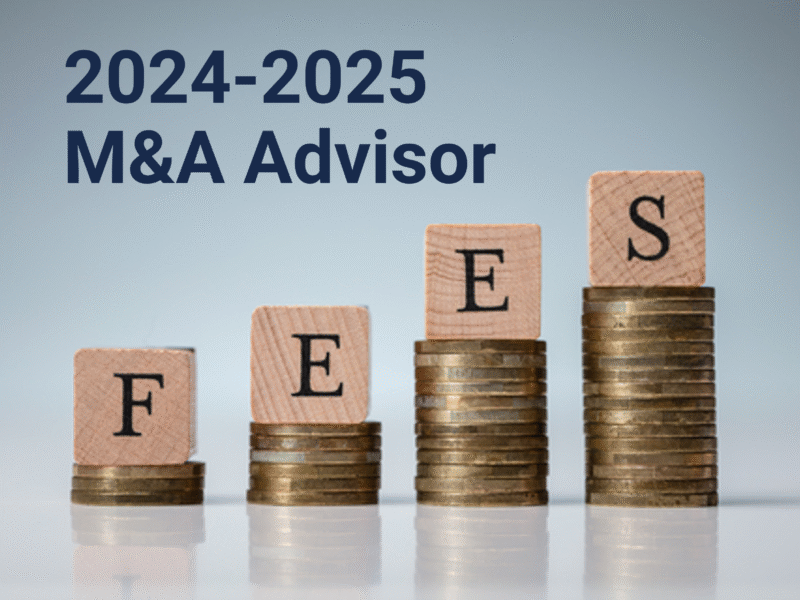Axial, Firmex, DealCircle, and Divestopedia have once again teamed up to provide the M&A Fee Guide for 2024-2025, offering insights into fees for middle-market advisors. Here, I’m summarizing the highlights and takeaways from both the report and my personal experience over the last couple of years. Keep in mind, the survey was done across multiple industries (not just IT, which is unique in its own way), with about half of respondents operating in the US, and half operating in Europe and elsewhere.
Here’s what’s new and what’s holding steady when it comes to M&A advisory fees this year.
A Transition Year for Advisor Fees
How have M&A advisor fees changed in the last few years?
As I mentioned in my article about M&A advisor fees for 2023-2024, the last couple years saw shifting fee structures due to longer deal timelines. But 2024 was primed to be a transition year due to rising interest rates and global elections. This led to most advisors holding their fees steady last year, despite rising costs. Only 34% of firms increased at least one type of fee, down from 47% the prior year. Still, half of all advisors reported revenue growth.
While expectations for 2025 were optimistic, deal volume growth in the US stalled, largely due to uncertainty around changing trade policies, specifically tariffs. Still, the potential for an upswing in late 2025 and early 2026 is possible, which has the potential to affect larger changes in advisor fees.
Engagement Fees
What are M&A advisor engagement fees 2024-2025?
Engagement fees, also known as work fees or commitment fees, are the fees advisors charge for their time and efforts to sell a company. These fees are paid by the seller whether the deal closes or not.
Advisors continue to move away from one-time retainers toward more predictable, ongoing fees based on time or milestones. This reduces risk for the advisor, especially in times where the market has more uncertainty.
Key data from the latest survey:
- 30% of firms charge monthly retainers
- 28% use a one-time fixed engagement fee
- 13% charge milestone-based fees, reflecting growing interest in tying payments to specific deal stages
- 9% charge hourly fees
- Only 16% of firms work solely on a success-fee basis
The typical monthly retainer remains at $5,000-$10,000. But there’s a notable shift toward higher tiers, with 16% of firms now charging $16,000 or more per month, double last year’s figure.
For fixed engagement fees, the most common range is $5,000–$25,000, though 38% now exceed $26,000 (up from 26%), particularly among larger firms.
Success Fees
What are M&A advisor success fees by deal size 2024-2025?
Success fees make up the bulk of an M&A advisor’s fees. They are a percentage of the final purchase price paid to the advisor once the deal successfully closes.
Success fee averages in 2024 edged slightly downward, especially for smaller transactions:
| Deal Size | 2023 Avg Success Fee | 2024 Avg Success Fee |
| $5M | ~5.5% | 4.8% |
| $20M | 3.8% | 3.4% |
| $100M | 2.1% | 2.0% |
When setting success fees, firms tend to consider 3 factors the most:
- The complexity of the transaction
- The risk of the deal not closing
- The size of the deal
The Lehman Formula remains the most common structure (used by 41% of firms).* This is where the commission rate decreases as the deal size increases.
The opposite accelerator formula has also become more popular, though, where the rate increases as the deal size increases. 21% are using this model, up from 16% last year.
Finally, 27% use a flat percentage regardless of deal size.
Minimum Fees
How common are minimum fees for M&A advisors in 2024-2025?
Only 25% of firms set formal minimum success fees, which is a minimum amount that must be paid regardless of the purchase price. It is more common with larger, $50M+ deals.
Earn-Outs and Timing
When does an M&A advisor get paid their success fee if there’s an earn-out?
Earn-out arrangements continue to have mixed levels of influence on when advisors get paid:
- About half (53%) of advisors require full payment at closing, which is slightly down from 58% in 2023.
- 41% of advisor will allow sellers to delay paying a portion of their success fee until the seller receives the earn-out, a sign of growing flexibility amid complex deal structures.
Other Key Shifts
- 57% of firms report deducting some or all engagement fees from the final success fees, up from 53% in 2023. This is often used as a compromise when there is pushback from clients on fees.
- Break-up fees remain stable, with about 28% of firms imposing them. These are charged when a client rejects an offer that meets their initial request.
- Expense reimbursement has become more common: 76% said they receive some reimbursement for expenses (up from 71%). The area that saw the greatest increase in reimbursements was the cost of virtual data rooms, with 48% charging clients for data room fees compared to 43% in 2023.
The Bottom Line
Despite some stagnation in 2024 and 2025, the M&A market remains healthy, especially in the IT sector. Technological advancements like AI are creating excitement and optimism, especially in the IT space. Advisors are reacting cautiously but optimistically to external factors and continue to be adaptable to ensure successful deals get done that both advisor and client can feel good about.
Words of Wisdom for Sellers
For sellers, my words of wisdom remain the same: be cautious of any advisor who is willing to work only for a success fee. I understand the draw of a lower price, but it can disincentivize the advisor from finding multiple quality buyers and negotiating the best price, terms, and fit. Rather, it can motivate them to find the first feasible offer and push it to the finish line as quickly as possible, regardless of the quality of the deal.
You want an advisor who is invested in the best possible outcome for you and your company (beyond just purchase price). A fair fee structure reflects this commitment, as well as the expertise, time, and risk your advisor assumes along the way.
And finally, it’s as important as ever to be ready in case that unsolicited offer unexpectedly lands in your lap. Advisors can do their job best if you’ve already started preparing your financials and educating yourself on the M&A process, so you can waste no time and take advantage of the right deal and the right timing.
Learn more about my courses and resources that can help you do just that here.
If you want to learn more about how RoseBiz’s fee structure works, feel free to reach out to us directly or fill out our Prospective Client Form for a quicker response.
* The Lehman Formula (also known as the Lehman Fee or Lehman Scale) is a commonly used method for defining compensation owed to an investment bank or deal broker for arranging a transaction. In the 70s and 80s, it was commonly used for fundraising and private placement transactions. Today, it is much more common in lower middle market acquisitions.
The original formula applied to transactions above $1 million and followed a 5-4-3-2-1 tiered structure:
- 5% of the first $1 million
- 4% of the second $1 million
- 3% of the third $1 million
- And so on, with 1% applying to anything over $5 million
Today, the Double Lehman formula is also popular, which doubles the rates for each transaction tier:
- 10% of the first $1 million
- 8% of the second $1 million
- 6% of the third $1 million
- and so on…


 The 20 Most Common Questions Business Owners Ask About Selling Their Company
The 20 Most Common Questions Business Owners Ask About Selling Their Company